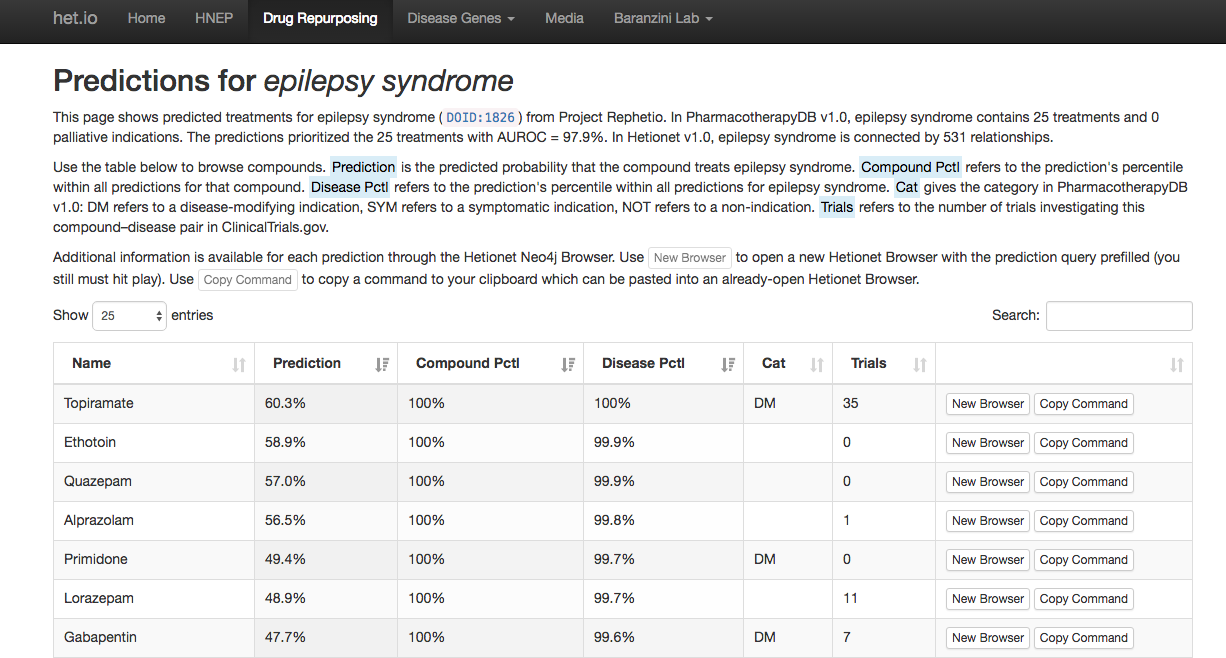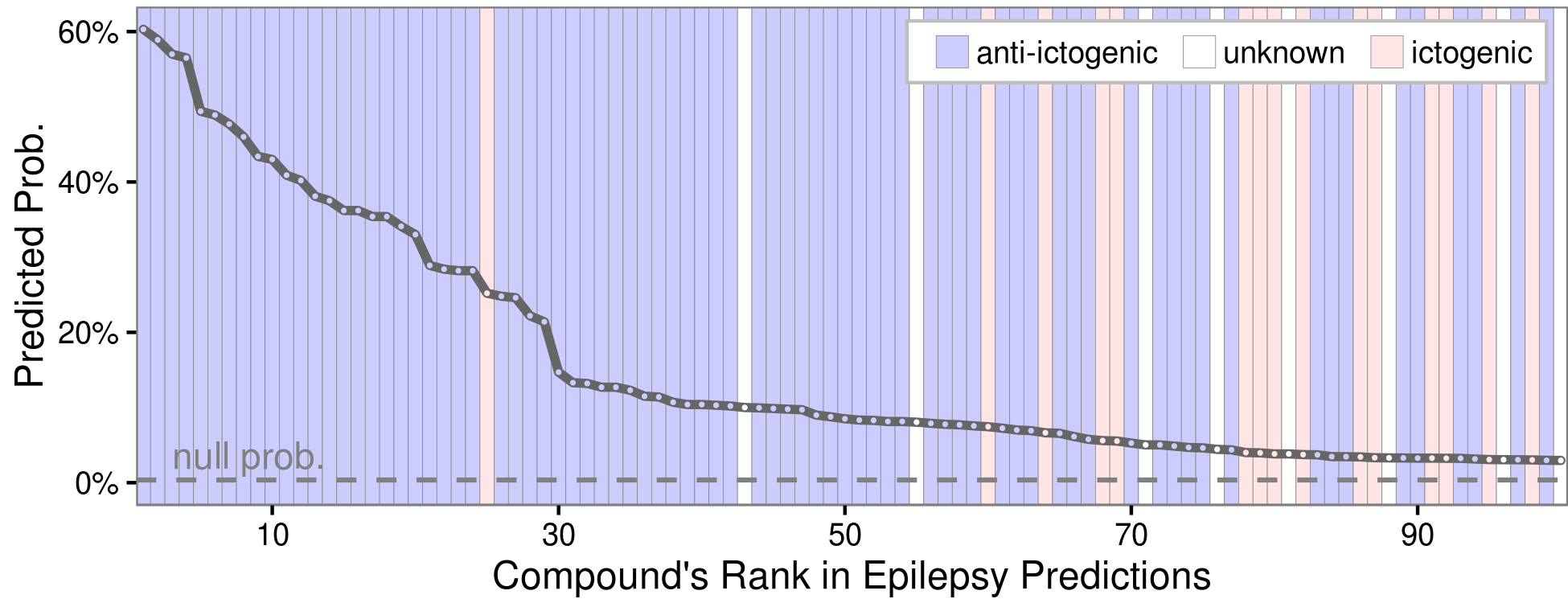Integrating data towards a systematic understanding of drug efficacy
February 21, 2017
Pfizer, Cambridge, MA
By Daniel Himmelstein
@dhimmel
Slides at slides.com/dhimmel/pfizer
How do you teach a computer biology?

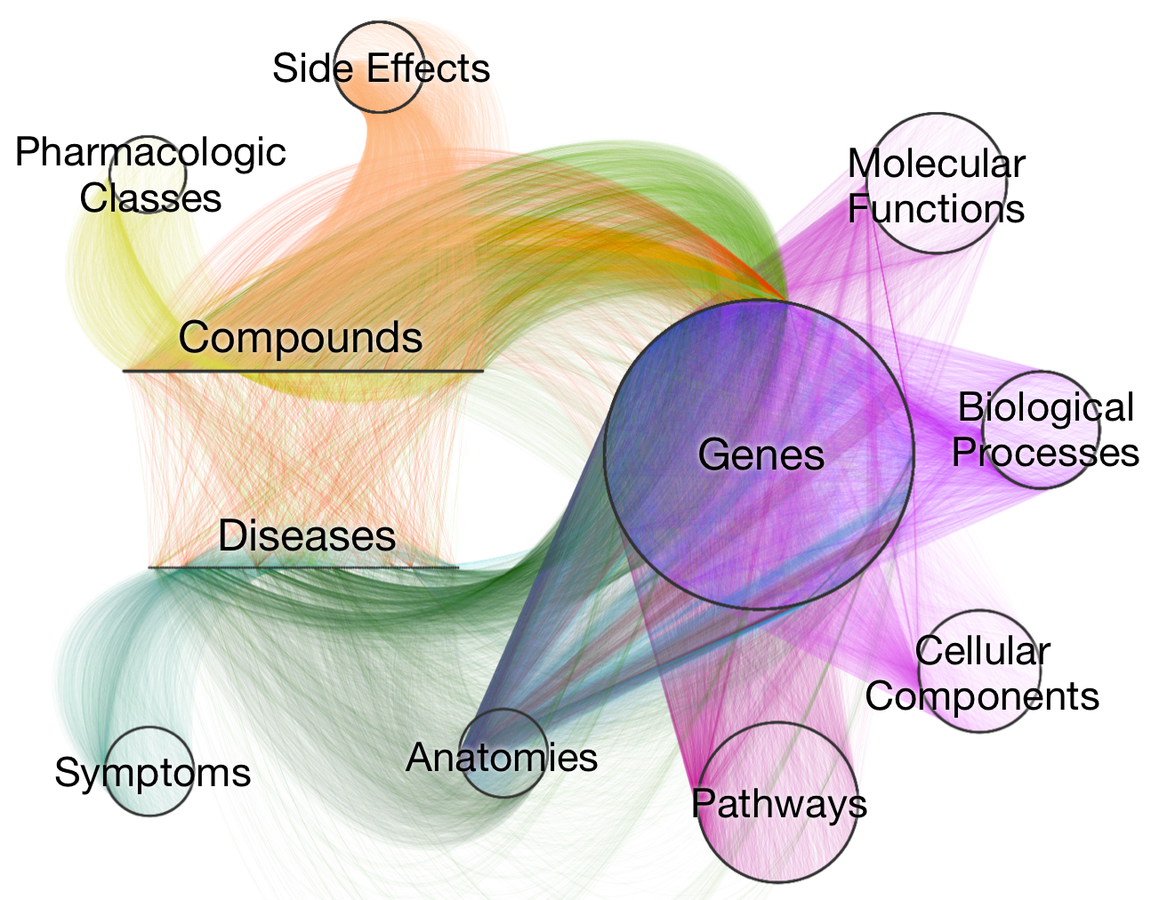
Visualizing Hetionet v1.0
- Hetnet of biology designed for drug repurposing
- ~50 thousand nodes
11 types (labels)
- ~2.25 million relationships
24 types
- integrates 29 public resources
knowledge from millions of studies
- online at https://neo4j.het.io
Hetionet v1.0
Project Rephetio: drug repurposing predictions
-
Hetionet v1.0 contains:
- 1,538 connected compounds
- 136 connected diseases
- 209,168 compound–disease pairs
- 755 treatments
- 1,206 compound–disease types of paths (with length ≤ 4)
- machine learning classifier
- predict the probability of treatment for all 209,168 compound–disease pairs (het.io/repurpose)
- Project online at thinklab.com/p/rephetio
Systematic integration of biomedical knowledge prioritizes drugs for repurposing
Daniel S Himmelstein, Antoine Lizee, Christine Hessler, Leo Brueggeman, Sabrina L Chen, Dexter Hadley, Ari Green, Pouya Khankhanian, Sergio E Baranzini
bioRxiv. 2016. DOI: 10.1101/087619

features = metapaths
observations =
compound–disease pairs
positives = treatments
negatives =
non-treatments
Machine learning methodology
slide added after presentation
1,206 compound–disease metapaths (length ≤ 4)
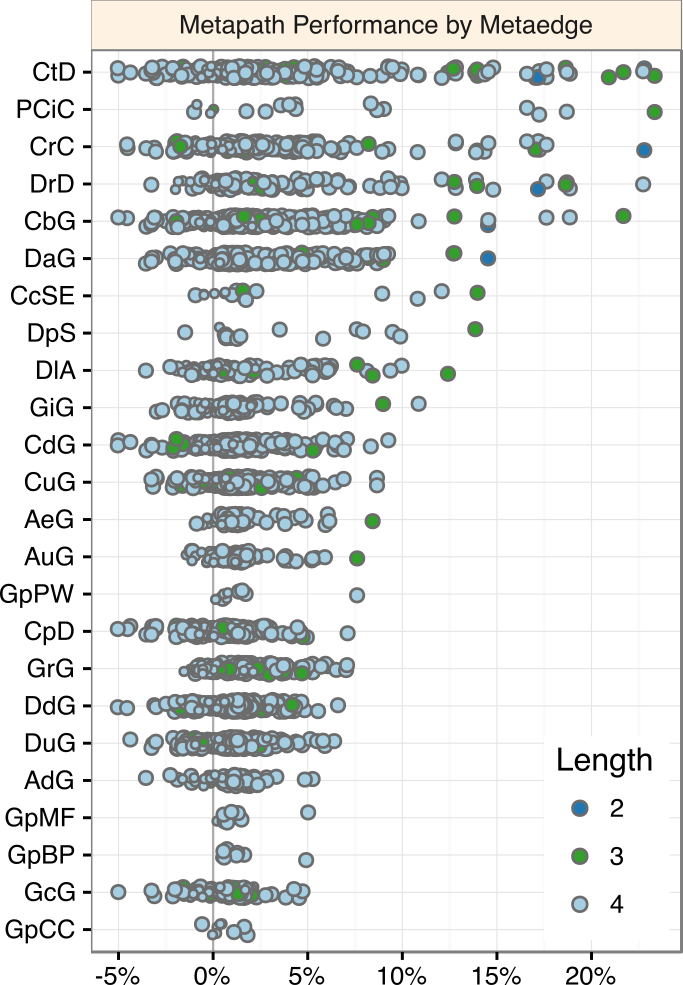
DWPC Δ AUROC
-
Upper tier:
traditional pharmacology -
Upper-middle tier:
traditionally biomedicine, but newer in drug efficacy -
Lower-middle tier:
genome-wide / high-throughput data sources -
Lower tier:
cellular components
slide added after presentation
Predictions succeed at prioritizing known treatments

Project Rephetio: Does bupropion treat nicotine dependence?
- Bupropion was first approved for depression in 1985
-
In 1997, bupropion was approved for smoking cessation
- Can we predict this repurposing from Hetionet? The prediction was:
- 99.5th percentile for nicotine dependence
- probability 2.50-fold greater than null

Compound–causes–SideEffect–causes–Compound–treats–Disease

Compound–binds–Gene–binds–Compound–treats–Disease

Compound–binds–Gene–associates–Disease

Compound–binds–Gene–participates–Pathway–participates–Disease
MATCH path = (n0:Compound)-[:BINDS_CbG]-(n1)-[:PARTICIPATES_GpPW]-
(n2)-[:PARTICIPATES_GpPW]-(n3)-[:ASSOCIATES_DaG]-(n4:Disease)
USING JOIN ON n2
WHERE n0.name = 'Bupropion'
AND n4.name = 'nicotine dependence'
AND n1 <> n3
WITH
[
size((n0)-[:BINDS_CbG]-()),
size(()-[:BINDS_CbG]-(n1)),
size((n1)-[:PARTICIPATES_GpPW]-()),
size(()-[:PARTICIPATES_GpPW]-(n2)),
size((n2)-[:PARTICIPATES_GpPW]-()),
size(()-[:PARTICIPATES_GpPW]-(n3)),
size((n3)-[:ASSOCIATES_DaG]-()),
size(()-[:ASSOCIATES_DaG]-(n4))
] AS degrees, path
RETURN
path,
reduce(pdp = 1.0, d in degrees| pdp * d ^ -0.4) AS path_weight
ORDER BY path_weight DESC
LIMIT 10Cypher query to find the top CbGbPWaD paths
Epilepsy predictions
(browse all predictions at het.io/repurpose)
Discuss at thinklab.com/d/224
Evaluating the top 100 epilepsy predictions
Discuss at thinklab.com/d/224#5
Top 100 epilepsy predictions & their chemical structure
Discuss at thinklab.com/d/224#5
Top 100 epilepsy predictions & their drug targets
Discuss at thinklab.com/d/230#14


Tissue-support requires both genes in the path to be expressed in the cardiovascular system.
Find the tissue-supported contribution of each pathway to treating CAD with enalapril (https://neo4j.het.io)
MATCH path = (n0:Compound)-[:BINDS_CbG]-(n1)-[:PARTICIPATES_GpPW]-
(n2)-[:PARTICIPATES_GpPW]-(n3)-[:ASSOCIATES_DaG]-(n4:Disease)
MATCH (n4)-[:LOCALIZES_DlA]-(anatomy)
MATCH (n1)-[:EXPRESSES_AeG]-(anatomy)-[:EXPRESSES_AeG]-(n3)
WHERE n0.name = 'Enalapril'
AND n4.name = 'coronary artery disease'
AND n1 <> n3
WITH
DISTINCT path,
n2 AS pathway,
[
size((n0)-[:BINDS_CbG]-()),
size(()-[:BINDS_CbG]-(n1)),
size((n1)-[:PARTICIPATES_GpPW]-()),
size(()-[:PARTICIPATES_GpPW]-(n2)),
size((n2)-[:PARTICIPATES_GpPW]-()),
size(()-[:PARTICIPATES_GpPW]-(n3)),
size((n3)-[:ASSOCIATES_DaG]-()),
size(()-[:ASSOCIATES_DaG]-(n4))
] AS degrees
RETURN
pathway.identifier AS pathway_id,
pathway.name AS pathway_name,
count(*) AS PC,
sum(reduce(pdp = 1.0, d in degrees| pdp * d ^ -0.4)) AS DWPC
ORDER BY DWPC DESC, pathway_nameMATCH path = (n0:SideEffect)-[r1:CAUSES_CcSE]
-(n1:Compound)-[r2:BINDS_CbG]-(n2:Gene)
WHERE n0.name = 'Cushingoid'
WITH
[
size((n0)-[:CAUSES_CcSE]-()),
size(()-[:CAUSES_CcSE]-(n1)),
size((n1)-[:BINDS_CbG]-()),
size(()-[:BINDS_CbG]-(n2))
] AS degrees, path, n2
WITH
n2,
count(path) AS PC,
sum(reduce(pdp = 1.0, d in degrees| pdp * d ^ -0.4)) AS DWPC
RETURN
n2.identifier AS gene_id,
n2.name AS gene_symbol,
n2.description AS gene_name,
PC, DWPC
ORDER BY DWPC DESC, gene_symbolWhat drug targets are responsible for the side effect of Cushingoid? https://neo4j.het.io
Query from https://thinklab.com/d/220#6
What drugs targer NR3C1 and also cause Cushingoid? https://neo4j.het.io
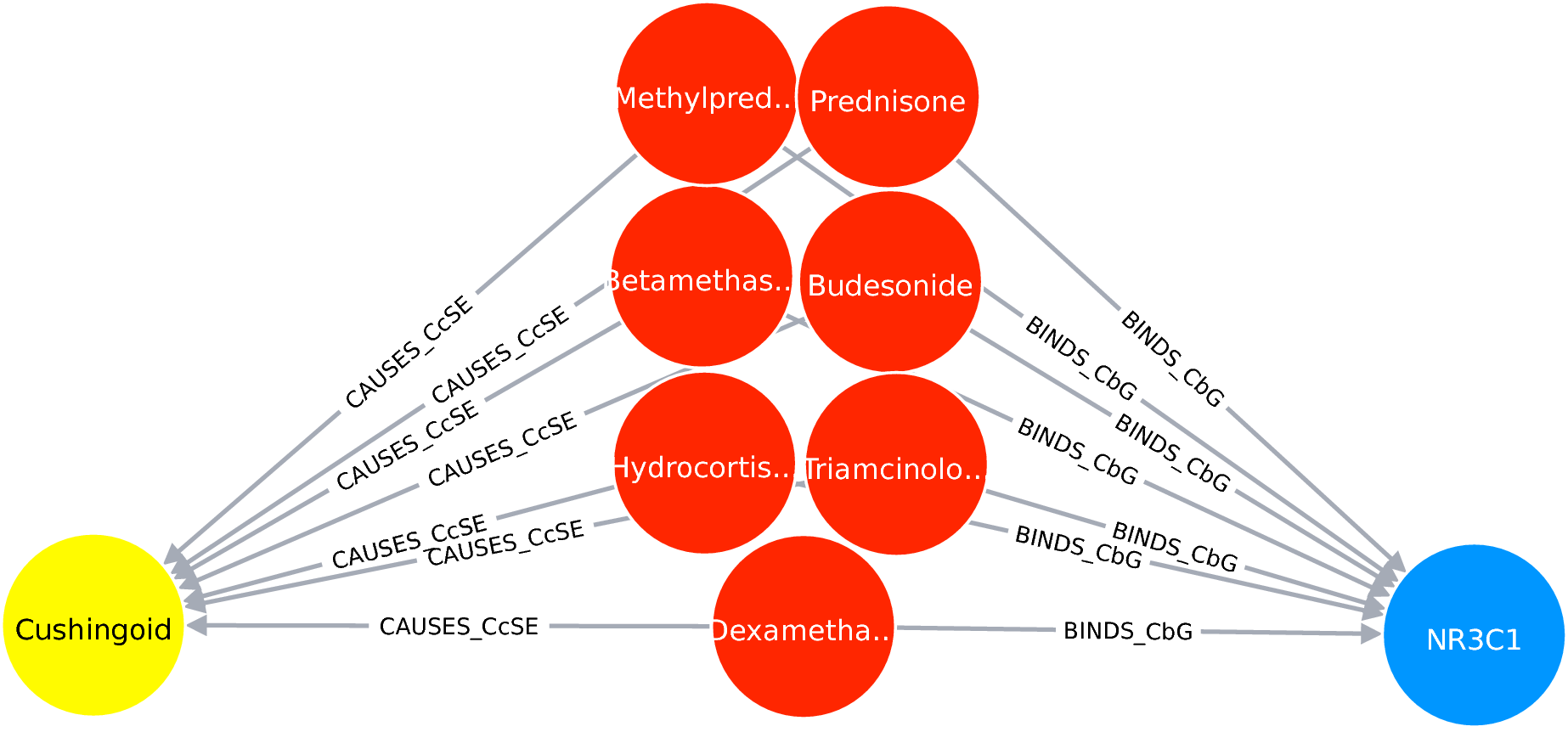
MATCH path = (n0:SideEffect)-[r1:CAUSES_CcSE]-(n1:Compound)-[r2:BINDS_CbG]-(n2:Gene)
WHERE n0.name = 'Cushingoid'
AND n2.name = 'NR3C1'
RETURN pathQuestions
Slides at slides.com/dhimmel/pfizer


